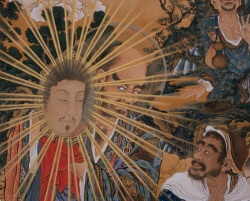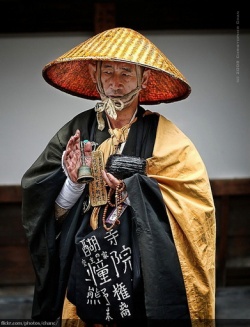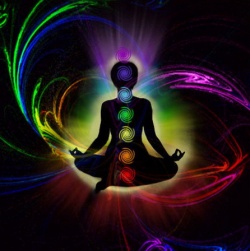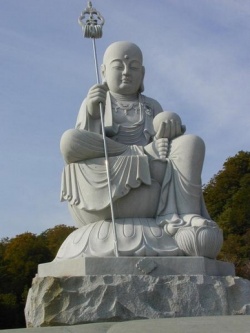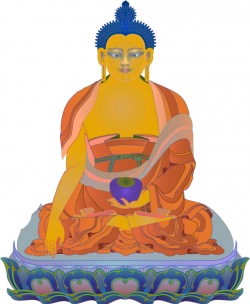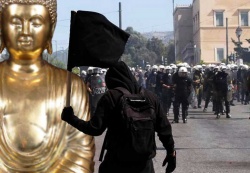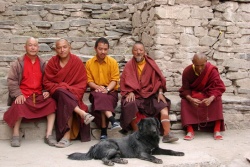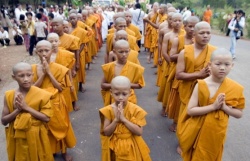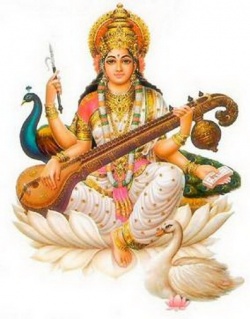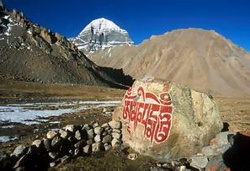Soma / Chandra, God of the Moon
Soma, according to the Vedic hymns, is the god who "represents and animates the juice of the Soma * plant."
He was the Indian Bacchus.
Not only are all the hymns of the ninth book of the Rig-Veda, one hundred and fourteen in number, besides a few in other places, dedicated to his honor, but constant references occur to him in a large proportion of other hymns. †
In some of these hymns he is extolled as the Creator, or Father of the gods.
Evidently at that time he was a most popular deity. Indra, as was stated before, was an enthusiastic worshipper of Soma.
From Atri's tears of jubilation was born a son named Soma, the moon, who was full of soothing rays.
Lord Brahmā appointed him the director of the brāhmaṇas, drugs and luminaries.
From the Vedas the following account of Soma is derived. †
In some passages the plant is said to have been brought from a mountain and given to Indra; in others, King Soma is said to have dwelt amongst the Gandharvas, a race of demi-gods that form the choir in Indra's heaven.
The gods, knowing the virtues of this king or plant—for the two terms seem to be indiscriminately applied—wished to obtain it.
Not knowing how to get it, Vach (the goddess of speech) said, "The Gandharvas are fond of women; let me go, and I will obtain it for you." The gods said, "How can we spare you?" She replied, "Obtain the god;
and I will then return to you, whenever you may want me." Another account of this affair is, that whilst the gods were living on earth,
Soma was in the sky.
Wishing to possess it, they sent Gayatri (a name of Brahmā's wife or daughter) to fetch it.
She went in the form of a bird, and was returning with it, when the Gandharvas seized it, and only gave it up when the goddess Vach went amongst them as narrated above.
When Soma was brought to the gods, a dispute arose as to who should have the first drought.
At length, this was decided by a race. Vāyu first reached the goal, Indra being second.
Indra tried hard to win, and when near the winning post proposed that they should reach it together, Vāyu taking two-thirds of the drink. Vāyu
said, "Not so! I will be the winner alone."
Then Indra said, "Let us come in together, and give me one-fourth of the drought divine!" Vāyu consented to this, and so the juice was shared between them. *
Soma is said to have had thirty-three wives, the daughters of Prajāpati; of these Rohini was the favorite.
Being dissatisfied with the partiality shown to their sister, the other wives returned to their father.
Soma asked that they might come back to him; the father consented to restore them, provided Soma would treat them all alike. Soma promised to do this; but, failing to keep his promise, he was smitten with consumption for breaking his word.
In the verses descriptive and songs in praise of Soma, the actual juice, and the god supposed to dwell in and manifested by it, are not at all distinct.
All the gods drink of it; and Soma, the god in the juice, is said to clothe the naked and heal the sick.
Many divine attributes are ascribed to him.
He is "addressed as a god in the highest strains of adulation and veneration.
All powers belong to him; all blessings are besought of him, as his to bestow."
He is said to be divine, immortal, and also to confer immortality on gods and men.
"In a passage where the joys of paradise are more distinctly anticipated and more fervently implored than in most other parts of the Rig-Veda, Soma is addressed as the god from whom the gift of future felicity is expected.
Thus it is there said, "Place me, O purified god, in that everlasting and imperishable world, where there is eternal light and glory. O Indu (Soma), flow for Indra!
Make me immortal in the world where Vaivasvata lives, where is the universal sphere of the sky, where those great waters flow." †
From the hymns addressed to this deity it is evident that at one time it was considered right for the Hindus to use intoxicants. Now as a rule they are forbidden.
Amongst the members of one branch of the worshippers of Kāli they are commonly indulged in, but with almost this single exception, the people do not touch them, and Soma, in his Vedic character has ceased to be worshipped.
In later years the name Soma was, and still is, given to the moon.
How and why this change took place is not known; but in the later of the Vedic hymns there is some evidence of the transition.
In the following passage Soma seems to he used in both senses—as god of the intoxicating juice, and as the moon ruling through the night. "
By Soma the Ādityas are strong; by Soma the earth is great; and Soma is placed in the midst of the stars. When they crush the plant, he who drinks regards it as Soma.
Of him whom the priests regard as Soma (the moon) no one drinks." *
In another passage this prayer is found: "May the god Soma, he whom they call the Moon, free me."
Again, "Soma is the moon, the food of the gods." "The sun has the nature of Agni, the moon of Soma."
In the "Vishnu Purāna" † we read, "Soma was appointed monarch of the stars and plants, of Brāhmans and plants, of sacrifices and penance."
In this Purāna we have quite a different account of the origin of Soma; but it must be borne in mind that in this account the term refers only to the moon.
At the time the "Vishnu Purāna" was written, intoxicants were strictly forbidden; hence Soma, as the god of the intoxicating juice, was no longer known and praised.
According to that Purāna, Soma was the son of Atri, the son of Brahmā.
He performed the Rājasuya sacrifice, and from the glory-thence acquired, and the immense dominion with which he had been invested, became so arrogant and licentious, that he carried off Tārā, the wife of Vrihaspati, the preceptor of the gods.
In vain Vrihaspati sought to recover his bride; in vain Brahmā commanded, and the holy sages remonstrated.
In consequence of this there was a great war; the gods fighting with Indra on the one side trying to recover Tārā; Soma with the demons on the other.
At length she appealed to Brahmā for protection, who thereupon commanded Soma to restore her.
On her return, Vrihaspati finding she was pregnant, refused to receive her until after the birth of her child.
In obedience to his orders, the child was immediately born; who being wonderful in beauty and power, both Vrihaspati and Soma claimed him as their son.
Tārā being referred to, was too much ashamed to speak.
The child was so indignant at this, that he was about to curse her, saying, "Unless you declare who is my father, I will sentence you to such a fate as shall deter every female from hesitating to speak the truth."
On this Brahmā again interfered, pacifying the child, and saying to Tārā, "Tell me, my child, is this the child of Vrihaspati or Soma?" "Of Soma," she said, blushing.
As soon as she had spoken, the lord of the constellations, his countenance being bright, embraced his son and said, "Well done, my boy; verily thou art wise;" and hence his name was Budha. *
Footnotes
69:* The Soma-plant of the Rig-Veda is the Asclepias acida of Roxburgh.
It is a creeping plant, almost destitute of leaves. It has small white fragrant flowers collected round the extremities of the branches.
Roxburgh says that it yields purer milky juice than any other plant he knows; and that this juice is mild, and of an acid nature.
The tender shoots are often plucked by native travelers. It grows on hills of the Punjab, in the Bolan Pass, in the neighborhood of Poona, etc.
In the Brāhmana of the Rig-Veda (Haug's Translation), is a most interesting account of the Soma sacrifice. This is occasionally made in the present day, but very few priests are acquainted with the ritual of this once celebrated sacrifice.
74:* This Budha, son of Soma, and regent of the planet Mercury, must not be confounded with Buddha, the teacher whose tenets are held by the Buddhists of the present day.
The two beings have nothing in common; and the names are identical only when one or other of them is misspelt.
Chandra was the original Indian god of the moon who was later merged with Soma.
He was white in color, and drove the moon chariot across the sky with ten white horses.
He was also a fertility god, for the dew which fell on the plants overnight and gave them life was seen as coming from the moon. Chandra was also prayed to when a couple wanted to have a child.
He is sometimes called the father of Budha and Tara is named as one of his consorts.
Soma is a very difficult deity for many outside of India to comprehend.
He works on numerous levels, all of which are tied together rather strangely.
Soma is firstly a plant. He is also an intoxicating drink which was brewed from that plant.
As the blood of animals and the sap of plants, Soma courses through all living things.
He is Inspiration to those who seek it, and so is the god of poets. He is also the god of the moon.
He is the dwelling place of the venerated dead, as well as the divine cure for evil.
The ancient Hindus did not differentiate between these divergent aspects; all were the god Soma.
Soma was one of the more important gods in the Rig Veda; 120 hymns and one entire book are dedicated to him.
He has many different forms. He is seen as a celestial bull, a bird, a giant rising from the waters, the lord of plants, and as an embryo. He rarely is seen as a fully grown human.
As a drink, Soma is the ambrosia of the gods.
It was due to this influence that they could rise above all obstacles to achieve their goals.
Indra was a great drinker of the substance; before his confrontation with Vritra, he drank rivers of it to gain the strength needed to overcome the fearsome dragon. Agni also consumed it in large amounts.
Soma was what gave the Vedic gods their immortality.
It was also a drink for mortals, a golden-hued nectar which was derived from the Soma plant, which may be a species known as ephedra vulgaris to botanists.
This drink brought hallucinations and ecstasy to those who consumed it.
It helped warriors to overcome their fears in battle, and it helped poets to become inspired to create. Soma was a bridge between the mortal world and that of the gods.
This drink is the same as Haoma in Persian mythology.
As the moon, Soma became equated with the god Chandra, who originally was the moon deity.
The moon was considered the cup which held the drink Soma for the gods, and one reason that the moon waxed and waned was due to this fact.
When the moon waned, it was because the gods were drinking down all the Soma; as it waxed, the god was re-creating himself, only to be consumed again once the cup was again full.
As the Vedic age ended and the Brahmans asserted themselves, the power of the gods no longer came from Soma but instead from sacrifices made by humans; Soma came more and more to be just a god of the moon.
In later times, the waxing and waning of the moon was due to a curse put on Soma.
Soma had twenty-seven wives (who correspond to the twenty-seven stations of the moon).
They were all the daughters of Daksha.
Daksha felt that Soma was paying too much attention to one of his daughters, thereby neglecting the rest. He cursed Soma to die a withering death.
But Soma's wives intervened, and so the death became only periodic; during half the month, the moon slowly dies away, but is reborn and comes around again to full vigor.
Though he is never depicted in human form, Soma obviously did not want for lovers; poets rarely do. In one episode, his desires caused a war. He had grown arrogant due to the glory that was offered him.
Because of this, he let his lust overcome him; he kidnaped and carried off Tara, the wife of the god Brihaspati.
After refusing to give her up, the gods made war on him to force her release, and Soma called on the asuras to aid him.
Finally Brahma interceded and compelled Soma to let Tara go.
But she was with child, and it ended up that this child was Soma's. The child was born and named Budha (not to be confused with the Buddha).
The `Soma` means juice or sap of the plants and thus Chandra is the lord of plants and vegetation.
Chandra is also considered as the Graha or planet according to Hindu astrology.
In Puranas (ancient Hindu legends), Chandra is described as a young, beautiful, fair, two-armed god who has a club and a lotus in his hands.
He rides a chariot pulled by ten white horses or an antelope and moves around the sky at night.
The other names of moon are Rajanipati (lord of night), Indu (the brighten drop) and Kshuparaka (one who illuminates the night).
Chandra has many wives namely Tara, Rohini, Anuradha and Bharani, who are the twenty-seven Nakshtras (constellations) and daughters of Daksha.
Budh (planet Mercury) is the son of Chandra and Tara.
As Soma, Chandra presides over Somvar or Monday.
Worshipping Chandra god on Mondays is very effective as it grants one`s prayer.
Chandra is also considered a fertility god since the dews that fall on plants overnight giving them life, seem to come from moon. Thus Chandra is prayed to when a couple wants to have a child.
As a `Graha` Chandra helps to get relief from the sorrows and cure mental afflictions.
According to Puranas, Chandra is thought to adore the head of Lord Shiva.
Sages and devotees invoke the Goddess mother in Chandra and meditate for hours.
The identity of the ancient plant known as Soma is one of the greatest unsolved mysteries in the field of religious history.
Common in the religious lore of both ancient India and Persia, the sacred Soma plant was considered a God.
When Soma was pressed and made into a drink, the ancient worshipper who imbibed it gained the powerful attributes of this God.
The drink was an important ritual drink among the early Indo-Iranians, and the subsequent Vedic and greater Persian cultures.
It is frequently mentioned in the Rigveda, whose Soma Mandala contains 114 hymns, many praising its energizing qualities.
In the Avesta, Soma has the entire Yašt 20 and Yasna9-11 dedicated to it.
The RigVeda calls the plant the “God for Gods” seemingly giving him precedence above Indra and the other Gods.
In the Vedas, Soma is portrayed as sacred and as a god (deva).
The god, the drink, and the plant refer to the same entity. Drinking Soma produces immortality.
Amrita is phonetically and conceptually very similar to the Greek ambrosia; both is what the gods drink, and what made them deities.
Indra and Agni are portrayed as consuming Soma in copious quantities.
The consumption of Soma by human beings is well attested in Vedic ritual.
It is described as prepared by extracting juice from the stalks of a certain plant.
In both Vedic and Zoroastrian tradition, the name of the drink and the plant are the same, and also personified as a divinity, the three forming a religious or mythological unity.
There has been much speculation concerning what is most likely to have been the identity of the original plant.
There is no solid consensus on the question, although most Western experts outside the Vedic and Avestan religious traditions now seem to favour a species of Ephedra, perhaps Ephedra sinica.
In Hindu art, the god Soma was depicted as a bull or bird, and sometimes as an embryo, but rarely as an adult human.
In Hinduism, the god Soma evolved into a lunar deity. Full moon is the time to collect and press the divine drink.
The moon is also the cup from which the gods drink Soma, thus identifying Soma with the moon god Chandra.
A waxing moon meant Soma was recreating himself, ready to be drunk again.
Alternatively, Soma’s twenty-seven wives were the star goddesses, the Nakshatras – daughters of the cosmic progenitor Daksha – who told their father that he paid too much attention to just one of them, Rohini.
Daksha subsequently cursed Soma to wither and die, but the wives intervened and the death became periodic and temporary, and is symbolized by the waxing and waning of the moon.
Monday is called Somavāram in Sanskrit and modern Indian languages, such as Hindi, Bengali, Kannada Marathi and Telugu, and alludes to the importance of this god in Hindu spirituality.
The Sushruta Samhita localizes the best Soma in the upper Indus and Kashmir region.
The Maharishi Mahesh Yogi’s Transcendental Meditation-Siddhi Program involves a notion of “Soma”, allegedly based on the Rigveda.
Candidates For The Soma Plant:
There has been much speculation as to the original Proto-Indo-Iranian Sauma plant.
Many descriptions of Soma are associated with excitation.
Soma is associated with the warrior-god Indra, and has been drunk by him before his battle with Vṛtra.
For these reasons, there are stimulant (amphetamine like) plants as well as entheogenic plants among the candidates that have been suggested.
Soma is also often associated with Light and Indra is the “Lord of Light” as shown in the following verses from the RgVeda: RV 8.82.25 For thee, O Lord of Light, are shed these Soma-drops, and grass is strewn.
Bring Indra to his worshippers.
May Indra give thee skill, and lights of heaven, wealth to his votary. And priests who praise him: laud ye him.
A more plausible, realistic explanation may be that the plant is opium, the region’s best known and most cultivated narcotic crop.
“Soma” is Vedic Sanskrit for “moon”, describing both the shape of the bulb and its nocturnal juice emission, which in ancient times would have been visible by moonlight only.
This term may be derived from the Sanskrit words “rddhi” and “hrdya”, which mean “magical”, “a type of medicinal plant”, and “heart-pleasing.”
To date, the upper South Asian belt of Afghanistan, Pakistan, northern India, and Burma still account for the world’s largest supply of opium.
